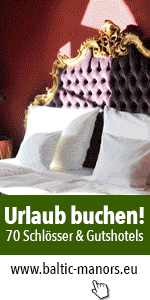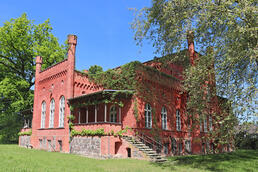Deutsche Website
Book "Manor houses and castles in Western Pomerania"

In Volume 3, we present 49 estates on 151 pages with short texts and more than 220 historical and current photographs.
Manor House Libnow
Duncker’s written explanation attached to the picture of the manor house Libnow says: “Since age-old times Libbnow has been a considerable property although documentation about its history is available merely fragmentary.
At multiple diggings in the fields foundations were found, remains of walls, and suchlike which indicate origins from ancient times. The Mecklenburg von Parsenow family (now extinct) held Libbnow in possession as a fiefdom of the Swedish crown. Their coat of arms showed an angel’s head in silver with black wings in a golden panel. After Libbnow was released from the fiefdom nexus it went to Count Friedrich Ludwig von Bohlen auf Carlsburg, who purchased it in 1792. He left the estate to his son-in-law the first Count of Bismarck-Bohlen. On August 11th, 1818 Theodor von Bismarck was ennobled to the title of count at the request of his father-in-law who was without male issue. He was granted permission to bear the name and the coat of arms of the house of Bohlen together with his own.
Count Bismarck-Bohlen sold Libbnow to the late Royal Councillor Homeyer whose youngest son is at present the owner of the feudal estate.
The whole estate has been newly established; the grand Tudor style manor house, the work of the highly esteemed master builder Drowatzky from Anklam, is situated amidst a tastefully landscaped garden and creates a favourable impression. The prominent water mill is driven by a brook which flows into the river Peene.”
Alexander Friedrich Wilhelm Duncker (1813 - 1897) was a German publisher and bookseller residing in Berlin.
His crowning accomplishment was a collection of graphic arts of Prussian castles, published during the years 1857 to 1883 entitled ‘The country houses, castles and residences of the knighthood landlords in the Prussian monarchy ...’
During the ensuing period a lot did change. On the estate the garden, the water mill, and auxiliary buildings with few exceptions have disappeared.
The patron of the present-day manor house Wilhelm Homeyer got married to Therese Kirstein in 1853, she was the daughter of the then lord mayor of the town of Swinemünde. After Homeyer's death in 1903 the 564 hectare estate was purchased by one Herr Sittmann of whom nothing much is known. But as soon as in 1911 one Oskar Schmidt is mentioned as the new owner and two years later even Professor Dr. Paul Silex from Berlin. During the period of 1922 to 1936 the brothers Gustav and Ludwig Samson were the proprietors. On the basis of their Jewish ancestry they had to sell the estate in 1936.
New owner then was Otto Hoene, a squire from East Prussia, who acquired it for his son Kurt Hoene. As Kurt died on the return flight from his honeymoon the management of the estate went to his brother Gerhard Hoene. After the death of Otto Hoene in February 1943 his daughter Dr. Elisabeth Hoene, a lawyer acting for the company of IG Farben, inherited the manor of Libnow. In April 1945 she was expropriated and exiled. As other manor houses the Liebnow house accommodated refugees in the aftermath of WW II. Up to 30 families supposedly inhabited the house at the same time.
During the 1970ties the manor house was purchased by the Magdeburg based dry cleaning company VEB “Edelweiß” (VEB = people-owned enterprise) and amongst others a sewing workshop site for GDR-apron dresses was established. The dry cleaning company made use of the house as a holiday camp for the children of their employees up to 1989. The ‘Treuhand’ took ownership in 1990 and tried to sell the manor house, during this period it did increasingly deteriorate due to lack of maintenance. (“Treuhand” = as of 1st July, 1990, the day of the currency change in the former GDR, all state-owned enterprises were converted into limited liability companies and stock companies the shares of which were held by the Treuhandanstalt. The most important task of the Treuhand (for short) was to privatise the assigned enterprises therefore acting as fiduciary.)
In 2000 married couple Dr. Beate Quies and Siegmund Lorenz purchased the highly dilapidated building. From the outset the arts were the intended use of house and grounds. Following ten years of most diligent restoration work the house again shone resplendently in its red colour. The gallery and art dealer’s shop “arte deposito” has in due course acquired a good reputation amongst artists and those interested in the arts due to it’s beautifully selected exhibitions and concerts. The frame manufactory of Siegmund Lorenz produces individual picture frames in traditional craftsmanship after intensively advising customers.
In 2008 guest rooms and a printing workshop have been completed. The organic fashion shop 'Luzifer' in the basement is complimented by a further business, the ’Usedom Antiquitäten’.





